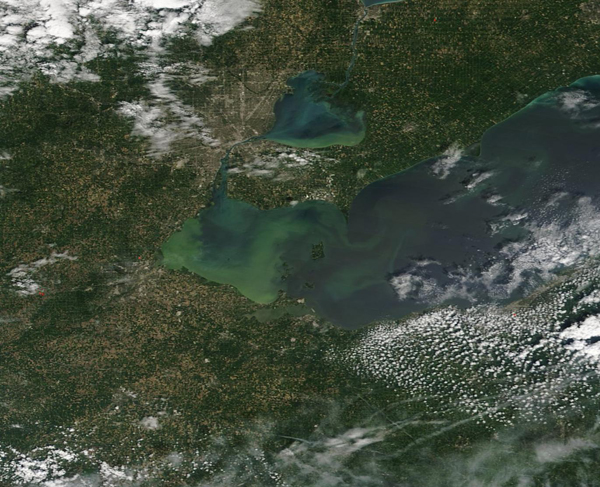Images
August 19, 2019 - Algal Bloom in Lake Erie
Tweet
In July 2019, a severe bloom of blue-green algae began spreading across the western half of Lake Erie. The dominant organism—a Microcystis cyanobacteria—produces the toxin microcystin, which can cause liver damage, numbness, dizziness, and vomiting. On July 29, the National Oceanic Atmospheric Administration (NOAA) reported unsafe toxin concentrations in Lake Erie and have since advised people (and their pets) to stay away from areas where scum is forming on the water surface. An updated report on August 14 showed that the harmful algae bloom (HAB) was most dense just offshore, stretching between Toledo, Ohio in the west and Sandusky, Ohio in the east. Slightly lower concentrations were found along the Michigan shoreline to Monroe. Decreasing, but still significant concentrations were found in almost all of the far western portion of Lake Erie, including along the southern shore of Lake Saint Claire. According to news reports, as of August 13, the algae bloom had spread across 620 square miles.
The Moderate Resolution Imaging Spectroradiometer (MODIS) on board NASA’s Terra satellite acquired a true-color image of the algae bloom on Lake Erie on August 14. The areas of green color correspond nicely with the NOAA map of HAB density, with the darkest color matching the highest concentration of harmful algae.
Image Facts
Satellite:
Terra
Date Acquired: 8/14/2019
Resolutions:
1km (113.5 KB), 500m (319.5 KB), 250m (263.5 KB)
Bands Used: 1,4,3
Image Credit:
MODIS Land Rapid Response Team, NASA GSFC
Tweet
In July 2019, a severe bloom of blue-green algae began spreading across the western half of Lake Erie. The dominant organism—a Microcystis cyanobacteria—produces the toxin microcystin, which can cause liver damage, numbness, dizziness, and vomiting. On July 29, the National Oceanic Atmospheric Administration (NOAA) reported unsafe toxin concentrations in Lake Erie and have since advised people (and their pets) to stay away from areas where scum is forming on the water surface. An updated report on August 14 showed that the harmful algae bloom (HAB) was most dense just offshore, stretching between Toledo, Ohio in the west and Sandusky, Ohio in the east. Slightly lower concentrations were found along the Michigan shoreline to Monroe. Decreasing, but still significant concentrations were found in almost all of the far western portion of Lake Erie, including along the southern shore of Lake Saint Claire. According to news reports, as of August 13, the algae bloom had spread across 620 square miles.
The Moderate Resolution Imaging Spectroradiometer (MODIS) on board NASA’s Terra satellite acquired a true-color image of the algae bloom on Lake Erie on August 14. The areas of green color correspond nicely with the NOAA map of HAB density, with the darkest color matching the highest concentration of harmful algae.
Image Facts
Satellite:
Terra
Date Acquired: 8/14/2019
Resolutions:
1km (113.5 KB), 500m (319.5 KB), 250m (263.5 KB)
Bands Used: 1,4,3
Image Credit:
MODIS Land Rapid Response Team, NASA GSFC




